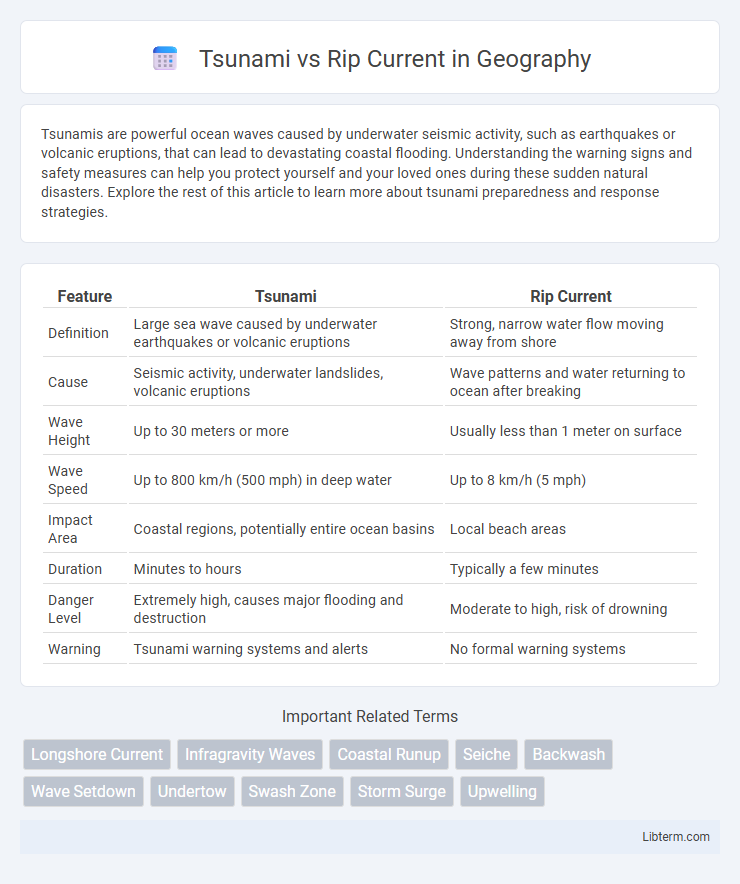Tsunamis are powerful ocean waves caused by underwater seismic activity, such as earthquakes or volcanic eruptions, that can lead to devastating coastal flooding. Understanding the warning signs and safety measures can help you protect yourself and your loved ones during these sudden natural disasters. Explore the rest of this article to learn more about tsunami preparedness and response strategies.
Table of Comparison
| Feature | Tsunami | Rip Current |
|---|---|---|
| Definition | Large sea wave caused by underwater earthquakes or volcanic eruptions | Strong, narrow water flow moving away from shore |
| Cause | Seismic activity, underwater landslides, volcanic eruptions | Wave patterns and water returning to ocean after breaking |
| Wave Height | Up to 30 meters or more | Usually less than 1 meter on surface |
| Wave Speed | Up to 800 km/h (500 mph) in deep water | Up to 8 km/h (5 mph) |
| Impact Area | Coastal regions, potentially entire ocean basins | Local beach areas |
| Duration | Minutes to hours | Typically a few minutes |
| Danger Level | Extremely high, causes major flooding and destruction | Moderate to high, risk of drowning |
| Warning | Tsunami warning systems and alerts | No formal warning systems |
Introduction to Tsunamis and Rip Currents
Tsunamis are large, powerful ocean waves generated primarily by underwater earthquakes, volcanic eruptions, or landslides, causing widespread coastal destruction. Rip currents are strong, narrow water channels moving away from the shore, posing significant risks to swimmers by pulling them out to deeper waters. Understanding the mechanics and warning signs of tsunamis and rip currents is crucial for coastal safety and disaster preparedness.
Causes: How Tsunamis and Rip Currents Form
Tsunamis form primarily due to underwater seismic activities such as earthquakes, volcanic eruptions, or landslides that displace large volumes of water, generating powerful, long-wavelength waves that travel across oceans. Rip currents are created by the interaction of waves breaking onshore and water flowing back to deeper water through narrow channels in the sandbar, resulting in concentrated, strong currents that pull swimmers away from the shore. Understanding these distinct causes helps in predicting and mitigating the hazards associated with tsunamis and rip currents.
Key Differences Between Tsunamis and Rip Currents
Tsunamis are large, powerful ocean waves caused by underwater seismic activity such as earthquakes, volcanic eruptions, or landslides, whereas rip currents are strong, narrow channels of fast-moving water flowing away from the shore. Tsunamis can travel across entire ocean basins, causing widespread destruction upon landfall, while rip currents are localized phenomena that primarily pose a risk to swimmers near beaches. The scale, origin, and potential impact distinguish tsunamis as rare but catastrophic events, in contrast to rip currents, which are common and present ongoing hazards for beachgoers.
Warning Signs: Identifying Tsunamis vs. Rip Currents
Tsunami warning signs include distant earthquakes, rapid sea level changes, and a loud roaring ocean sound, indicating an approaching massive wave. Rip currents typically form near breaking waves and are recognized by choppy water, a noticeable channel of churning or choppy water, and debris moving steadily seaward. Understanding these key indicators helps beachgoers differentiate between a life-threatening tsunami and a localized rip current hazard.
Impacts on Coastal Communities
Tsunamis cause widespread destruction with massive flooding, property damage, and loss of life due to their immense wave height and force, often resulting in long-term displacement of coastal communities. Rip currents primarily pose a drowning risk to swimmers by pulling them away from shore, but their localized impact is less severe compared to tsunamis. Coastal infrastructure resilience and emergency response planning are critical for mitigating tsunami impacts, whereas public awareness and swimmer education reduce rip current accidents.
Safety Tips for Tsunami and Rip Current Situations
In tsunami situations, immediately move to higher ground or inland away from the coast to avoid the powerful waves and flooding. For rip currents, swim parallel to the shore to escape the current's pull before attempting to swim back to land. Always stay informed about local warnings and never ignore evacuation orders issued by authorities during either event.
Rescue and Survival Strategies
Tsunami rescue strategies emphasize rapid evacuation to higher ground and following official warnings due to the massive size and speed of incoming waves. Rip current survival involves swimming parallel to the shore to escape the narrow, fast-moving water channel instead of fighting against it. Both emergencies require maintaining calm, signaling for help, and prioritizing swift, informed actions to enhance chances of survival.
Environmental and Ecological Consequences
Tsunamis cause massive coastal flooding, leading to widespread destruction of marine habitats, including coral reefs and mangroves, resulting in long-term ecological imbalance. Rip currents primarily affect localized beach environments by altering sediment distribution and disrupting nearshore ecosystems but generally cause less extensive damage. Both phenomena impact water quality by increasing turbidity and introducing pollutants, which can harm aquatic life and degrade coastal biodiversity.
Common Misconceptions About Tsunamis and Rip Currents
Tsunamis are often mistakenly believed to be giant, towering waves visible far out in the ocean, but they are actually a series of fast-moving ocean waves caused by underwater seismic activity. Rip currents are commonly confused with tides or undertows, yet they are narrow, powerful channels of water moving away from shore that can pull swimmers out to sea. Both phenomena pose significant drowning risks, requiring awareness of their distinct behaviors for effective beach safety and rescue measures.
Conclusion: Understanding Ocean Hazards
Tsunamis and rip currents both pose significant ocean hazards but differ in origin, scale, and impact. Tsunamis result from seismic activity, causing massive, long-wavelength waves that can inundate coastlines, while rip currents are fast-moving channels of water flowing away from shore, posing drowning risks to swimmers. Understanding these distinctions enhances coastal safety measures and informs effective emergency response strategies.
Tsunami Infographic

 libterm.com
libterm.com